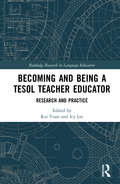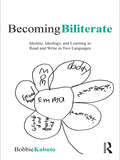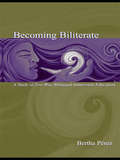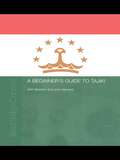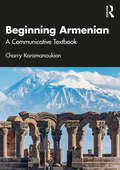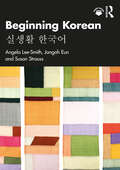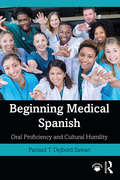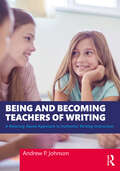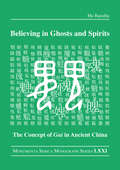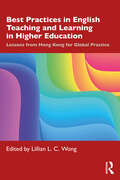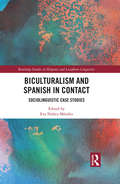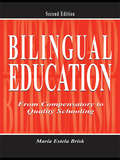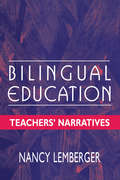- Table View
- List View
Becoming and Being a TESOL Teacher Educator: Research and Practice (Routledge Research in Language Education)
by Rui Yuan Icy LeeThis book offers insights into the lived experiences (e.g., teaching, research, and practicum supervision) of TESOL teacher educators in diverse institutional and socio-cultural contexts. Informed by a situated, ecological perspective, it draws on a variety of research approaches (e.g., qualitative, action research, and self-study), and sheds light on how language teacher educators engage in daily practice and social interactions. This edited collection examines how TESOL educators cope with potential contextual obstacles (e.g., the theory-practice divide), and how they seek their continuing professional development in complex, shifting higher education settings. The book offers critical and thoughtful reflections of current practice and policies in language education and higher education, and provides practical implications on the preparation and development of frontline language teachers.
Becoming Biliterate: Identity, Ideology, and Learning to Read and Write in Two Languages
by Bobbie KabutoThrough the real-life context of one child learning to be bilingual and biliterate, this book raises questions and provides a context for pre-service and practicing teachers to understand and reflect on how children learn to read and write in multiple languages. Highlighting the social and cognitive advantages of biliteracy, its purpose is to help teachers better understand the complexity by which young children become biliterate as they actively construct meaning and work through tensions resulting from their everyday life circumstances. Perspectives regarding identity and language ideologies are presented to help teachers refine their own pedagogical approaches to teaching linguistically diverse children. Readers are engaged in understanding early biliteracy through a process of articulating and questioning their own assumptions and beliefs about learning in multiple languages and literacies.
Becoming Biliterate: Identity, Ideology, and Learning to Read and Write in Two Languages
by Bobbie KabutoThrough the real-life context of one child learning to be bilingual and biliterate, this book raises questions and provides a context for pre-service and practicing teachers to understand and reflect on how children learn to read and write in multiple languages. Highlighting the social and cognitive advantages of biliteracy, its purpose is to help teachers better understand the complexity by which young children become biliterate as they actively construct meaning and work through tensions resulting from their everyday life circumstances. Perspectives regarding identity and language ideologies are presented to help teachers refine their own pedagogical approaches to teaching linguistically diverse children. Readers are engaged in understanding early biliteracy through a process of articulating and questioning their own assumptions and beliefs about learning in multiple languages and literacies.
Becoming Biliterate: A Study of Two-Way Bilingual Immersion Education
by Bertha PerezThis book describes the development process and dynamics of change in the course of implementing a two-way bilingual immersion education program in two school communities. The focus is on the language and literacy learning of elementary-school students and on how it is influenced by parents, teachers, and policymakers. Pérez provides rich, highly detailed descriptions, both quantitative and qualitative, of the change process at the two schools involved, including student language and achievement data for five years of program implementation that were used to test the basic two-way bilingual theory, the specific school interventions, and the particular classroom instructional practices. The contribution of Becoming Biliterate: A Study of Two-Way Bilingual Immersion Education is to provide a comprehensive description of contextual and instructional factors that might help or hinder the attainment of successful literacy and student outcomes in both languages. The study has broad theoretical, policy, and practical instructional relevance for the many other U.S. school districts with large student populations of non-native speakers of English. This volume is highly relevant for researchers, teacher educators, and graduate students in bilingual and ESL education, language policy, linguistics, and language education, and as a text for master's- and doctoral-level classes in these areas.
Becoming Biliterate: A Study of Two-Way Bilingual Immersion Education
by Bertha PerezThis book describes the development process and dynamics of change in the course of implementing a two-way bilingual immersion education program in two school communities. The focus is on the language and literacy learning of elementary-school students and on how it is influenced by parents, teachers, and policymakers. Pérez provides rich, highly detailed descriptions, both quantitative and qualitative, of the change process at the two schools involved, including student language and achievement data for five years of program implementation that were used to test the basic two-way bilingual theory, the specific school interventions, and the particular classroom instructional practices. The contribution of Becoming Biliterate: A Study of Two-Way Bilingual Immersion Education is to provide a comprehensive description of contextual and instructional factors that might help or hinder the attainment of successful literacy and student outcomes in both languages. The study has broad theoretical, policy, and practical instructional relevance for the many other U.S. school districts with large student populations of non-native speakers of English. This volume is highly relevant for researchers, teacher educators, and graduate students in bilingual and ESL education, language policy, linguistics, and language education, and as a text for master's- and doctoral-level classes in these areas.
A Beginners' Guide to Tajiki
by Azim Baizoyev John HaywardThis is a conversational approach to the teaching and learning of the Tajiki language. It uses authentic language material to help learners as they proceed through its topic-based lessons. Its emphasis on the spoken language promotes oral fluency alongside written skills. Both lessons and appendices present new vocabulary and grammar simply and recycle material to provide opportunities for both controlled and free language learning.The appendices include not only lists of useful information and samples of commonly needed letters and speeches but also an invaluable introduction to Tajiki grammar and a comprehensive Tajiki-English dictionary of all the book's vocabulary - over 4500 definitions.
A Beginners' Guide to Tajiki
by Azim Baizoyev John HaywardThis is a conversational approach to the teaching and learning of the Tajiki language. It uses authentic language material to help learners as they proceed through its topic-based lessons. Its emphasis on the spoken language promotes oral fluency alongside written skills. Both lessons and appendices present new vocabulary and grammar simply and recycle material to provide opportunities for both controlled and free language learning.The appendices include not only lists of useful information and samples of commonly needed letters and speeches but also an invaluable introduction to Tajiki grammar and a comprehensive Tajiki-English dictionary of all the book's vocabulary - over 4500 definitions.
Beginning Armenian: A Communicative Textbook
by Charry KaramanoukianBeginning Armenian: A Communicative Textbook introduces conversational Western and Eastern Armenian in a single volume, allowing learners to acquire the language skills they need to communicate and to reference, contrast, and compare both standards of the language. This book contains 24 lessons, each providing a range of key vocabulary and addressing different topics of daily life, including greetings, people, and objects, as well as past and future plans. An overview of the Western and Eastern Armenian alphabet, pronunciation, and punctuation is complimented by a range of exercises introducing the basics of Armenian grammar and vocabulary, with interactive information gap and role play activities designed to develop essential conversation skills. Beginning Armenian is the ideal textbook to introduce class-based and independent learners to the Armenian language.
Beginning Armenian: A Communicative Textbook
by Charry KaramanoukianBeginning Armenian: A Communicative Textbook introduces conversational Western and Eastern Armenian in a single volume, allowing learners to acquire the language skills they need to communicate and to reference, contrast, and compare both standards of the language. This book contains 24 lessons, each providing a range of key vocabulary and addressing different topics of daily life, including greetings, people, and objects, as well as past and future plans. An overview of the Western and Eastern Armenian alphabet, pronunciation, and punctuation is complimented by a range of exercises introducing the basics of Armenian grammar and vocabulary, with interactive information gap and role play activities designed to develop essential conversation skills. Beginning Armenian is the ideal textbook to introduce class-based and independent learners to the Armenian language.
Beginning Korean: 실생활 한국어
by Angela Lee-Smith Jongoh Eun Susan StraussBeginning Korean is a Korean language textbook for use at the high school and college levels, involving characters who speak and interact in Korean using beginner-to-intermediate-level expressions, vocabulary, and grammar.The book contains a rich variety of natural-sounding dialogues involving characters from a diverse range of backgrounds as they exchange ideas, make plans, and socialize in a variety of natural contexts in Korea. The book provides a wide variety of conversational expressions, grammar notes, and vocabulary items, in addition to ‘Cultural Insights’ to expand users’ understandings of and familiarity with Korean culture from more insider perspectives.Further supporting material, including audio, can be found at www.routledge.com/9781032687032. The book is designed around ACTFL’s 5 Cs (Communication, Cultures, Connections, Comparisons, and Communities) and includes specific proficiency-based Can-Do learning goals for each unit. As such, the content, topics, and areas of focus in this book can be useful for a wide range of programs, educators, and learners of Korean.
Beginning Korean: 실생활 한국어
by Angela Lee-Smith Jongoh Eun Susan StraussBeginning Korean is a Korean language textbook for use at the high school and college levels, involving characters who speak and interact in Korean using beginner-to-intermediate-level expressions, vocabulary, and grammar.The book contains a rich variety of natural-sounding dialogues involving characters from a diverse range of backgrounds as they exchange ideas, make plans, and socialize in a variety of natural contexts in Korea. The book provides a wide variety of conversational expressions, grammar notes, and vocabulary items, in addition to ‘Cultural Insights’ to expand users’ understandings of and familiarity with Korean culture from more insider perspectives.Further supporting material, including audio, can be found at www.routledge.com/9781032687032. The book is designed around ACTFL’s 5 Cs (Communication, Cultures, Connections, Comparisons, and Communities) and includes specific proficiency-based Can-Do learning goals for each unit. As such, the content, topics, and areas of focus in this book can be useful for a wide range of programs, educators, and learners of Korean.
Beginning Medical Spanish: Oral Proficiency and Cultural Humility
by Parizad T. Dejbord SawanBeginning Medical Spanish. Oral Proficiency and Cultural Humility is designed for medical professionals and supporting staff with no prior knowledge of Spanish who need to develop oral language skills and cross-cultural sensitivity to establish relationship-building communication with their Spanish-speaking patients. This hospital-tested program teaches how to connect with patients of limited English-speaking ability and offer them the quality care they seek. Role-play activities allow students to develop their oral proficiency in meaningful contexts and contribute to a creative and dynamic classroom environment. Written exercises provide opportunity for practice outside the classroom, and audio recordings are available online for use in class and at home. The cultural readings and extensive bibliographical references in each chapter provide students with information about Hispanic values, beliefs and health practices, while teaching them to consider how these may vary with the identity of each individual and the degree of acculturation to US "mainstream" culture. Whether you are a student preparing to work in a medical environment, or a professional already working with Spanish-speaking patients, the innovative method of hands-on learning though role-playing practice provided in this program will give you the specific skills you need to communicate confidently and respectfully in Spanish.
Beginning Medical Spanish: Oral Proficiency and Cultural Humility
by Parizad T. Dejbord SawanBeginning Medical Spanish. Oral Proficiency and Cultural Humility is designed for medical professionals and supporting staff with no prior knowledge of Spanish who need to develop oral language skills and cross-cultural sensitivity to establish relationship-building communication with their Spanish-speaking patients. This hospital-tested program teaches how to connect with patients of limited English-speaking ability and offer them the quality care they seek. Role-play activities allow students to develop their oral proficiency in meaningful contexts and contribute to a creative and dynamic classroom environment. Written exercises provide opportunity for practice outside the classroom, and audio recordings are available online for use in class and at home. The cultural readings and extensive bibliographical references in each chapter provide students with information about Hispanic values, beliefs and health practices, while teaching them to consider how these may vary with the identity of each individual and the degree of acculturation to US "mainstream" culture. Whether you are a student preparing to work in a medical environment, or a professional already working with Spanish-speaking patients, the innovative method of hands-on learning though role-playing practice provided in this program will give you the specific skills you need to communicate confidently and respectfully in Spanish.
Being and Becoming Teachers of Writing: A Meaning-Based Approach to Authentic Writing Instruction
by Andrew P. JohnsonThis engaging, inviting textbook from a renowned expert in writing education provides all the knowledge, pedagogical strategies, and tools needed to enable any teacher to be an effective teacher of writing.Using the five-step writing process as a foundation, the text describes how to teach the necessary skills related to grammar, spelling, punctuation, and other writing mechanics, and addresses all major genres and stages of writing. Written in an authentic voice that exemplifies good writing, Johnson presents a variety of pragmatic, research-based strategies that support students’ writing development and encourage teachers to apply their own creativity and intelligence in the classroom.This is an essential text for courses in writing instruction, literacy methods, and teaching English Language Arts (ELA).
Being and Becoming Teachers of Writing: A Meaning-Based Approach to Authentic Writing Instruction
by Andrew P. JohnsonThis engaging, inviting textbook from a renowned expert in writing education provides all the knowledge, pedagogical strategies, and tools needed to enable any teacher to be an effective teacher of writing.Using the five-step writing process as a foundation, the text describes how to teach the necessary skills related to grammar, spelling, punctuation, and other writing mechanics, and addresses all major genres and stages of writing. Written in an authentic voice that exemplifies good writing, Johnson presents a variety of pragmatic, research-based strategies that support students’ writing development and encourage teachers to apply their own creativity and intelligence in the classroom.This is an essential text for courses in writing instruction, literacy methods, and teaching English Language Arts (ELA).
Believing in Ghosts and Spirits: The Concept of Gui in Ancient China (Monumenta Serica Monograph Series)
by Hu BaozhuThe present book by Hu Baozhu explores the subject of ghosts and spirits and attempts to map the religious landscape of ancient China. The main focus of attention is the character gui 鬼, an essential key to the understanding of spiritual beings. The author analyses the character gui in various materials – lexicons and dictionaries, excavated manuscripts and inscriptions, and received classical texts. Gui is examined from the perspective of its linguistic root, literary interpretation, ritual practices, sociopolitical implication, and cosmological thinking. In the gradual process of coming to know the otherworld in terms of ghosts and spirits, Chinese people in ancient times attempted to identify and classify these spiritual entities. In their philosophical thinking, they connected the subject of gui with the movement of the universe. Thus the belief in ghosts and spirits in ancient China appeared to be a moral standard for all, not only providing a room for individual religiosity but also implementing the purpose of family-oriented social order, the legitimization of political operations, and the understanding of the way of Heaven and Earth.
Believing in Ghosts and Spirits: The Concept of Gui in Ancient China (Monumenta Serica Monograph Series)
by Hu BaozhuThe present book by Hu Baozhu explores the subject of ghosts and spirits and attempts to map the religious landscape of ancient China. The main focus of attention is the character gui 鬼, an essential key to the understanding of spiritual beings. The author analyses the character gui in various materials – lexicons and dictionaries, excavated manuscripts and inscriptions, and received classical texts. Gui is examined from the perspective of its linguistic root, literary interpretation, ritual practices, sociopolitical implication, and cosmological thinking. In the gradual process of coming to know the otherworld in terms of ghosts and spirits, Chinese people in ancient times attempted to identify and classify these spiritual entities. In their philosophical thinking, they connected the subject of gui with the movement of the universe. Thus the belief in ghosts and spirits in ancient China appeared to be a moral standard for all, not only providing a room for individual religiosity but also implementing the purpose of family-oriented social order, the legitimization of political operations, and the understanding of the way of Heaven and Earth.
Best Practices in English Teaching and Learning in Higher Education: Lessons from Hong Kong for Global Practice
by Lillian L. C. WongLillian Wong brings together evidence- informed studies which are at the forefront of higher education developments in English language teaching and learning, and shares expertise from prominent academics in Hong Kong. Written by experienced practitioners who are active in the evolving field of scholarship of teaching and learning, it provides accessible and engaging insights into best practices in new and innovative areas, such as communities of practice, scholarship, big data analytics, digital literacies, blended learning, small private online courses, dialogic use of exemplars, students as tutors and critical thinking. The book covers best practices in three interrelated key areas in university English language education, including curriculum design and pedagogy, use of technologies and the teaching and learning of English in the disciplines. Linking theory and practice, the chapters discuss the emphasis on EAP/ ESP in university English language education, how technological developments are impacting the field and the implications for further research and the teaching of English in higher education. This resourceful collection is essential reading for teachers in- service and intraining, or those working in language education at the tertiary level where English is being used as an academic lingua franca, a medium of instruction or where EAP/ ESP plays an important role. Researchers in TESOL and applied linguistics, curriculum designers and leaders, teacher educators and policymakers as well as undergraduate and postgraduate students will also find it valuable.
Best Practices in English Teaching and Learning in Higher Education: Lessons from Hong Kong for Global Practice
by Wong, Lillian L. CLillian Wong brings together evidence- informed studies which are at the forefront of higher education developments in English language teaching and learning, and shares expertise from prominent academics in Hong Kong. Written by experienced practitioners who are active in the evolving field of scholarship of teaching and learning, it provides accessible and engaging insights into best practices in new and innovative areas, such as communities of practice, scholarship, big data analytics, digital literacies, blended learning, small private online courses, dialogic use of exemplars, students as tutors and critical thinking. The book covers best practices in three interrelated key areas in university English language education, including curriculum design and pedagogy, use of technologies and the teaching and learning of English in the disciplines. Linking theory and practice, the chapters discuss the emphasis on EAP/ ESP in university English language education, how technological developments are impacting the field and the implications for further research and the teaching of English in higher education. This resourceful collection is essential reading for teachers in- service and intraining, or those working in language education at the tertiary level where English is being used as an academic lingua franca, a medium of instruction or where EAP/ ESP plays an important role. Researchers in TESOL and applied linguistics, curriculum designers and leaders, teacher educators and policymakers as well as undergraduate and postgraduate students will also find it valuable.
Biculturalism and Spanish in Contact: Sociolinguistic Case Studies (Routledge Studies in Hispanic and Lusophone Linguistics)
by Eva Núñez MéndezBiculturalism and Spanish in Contact: Sociolinguistic Case Studies provides an original and modern analysis of the field of language change and variation with a specific focus on Spanish as a language in contact. This edited collection, focuses on diachronic variationist approaches to the Spanish language in contact with other languages from a historical sociolinguistics perspective. Topics covered include: language planning and policies, education, biculturalism, linguistic variation issues in the Spanish of the southwestern United States, and other socio-historical and anthropological aspects of the contact situation.
Biculturalism and Spanish in Contact: Sociolinguistic Case Studies (Routledge Studies in Hispanic and Lusophone Linguistics)
by Eva Núñez-Méndez Dale Koike Javier Muñoz-BasolsBiculturalism and Spanish in Contact: Sociolinguistic Case Studies provides an original and modern analysis of the field of language change and variation with a specific focus on Spanish as a language in contact. This edited collection, focuses on diachronic variationist approaches to the Spanish language in contact with other languages from a historical sociolinguistics perspective. Topics covered include: language planning and policies, education, biculturalism, linguistic variation issues in the Spanish of the southwestern United States, and other socio-historical and anthropological aspects of the contact situation.
Bilingual Education: From Compensatory To Quality Schooling
by María Estela BriskBilingual Education: From Compensatory to Quality Schooling, Second Edition maintains its original purpose of synthesizing the research on successful bilingual education in order to demonstrate that quality bilingual education is possible and desirable.Findings from a wide range of studies are integrated to provide a clear picture of bilingual education in today's schools, and a professional understanding of the foundations and issues surrounding bilingual education programs. The recommendations offered provide a comprehensive basis for planning, developing, improving, and evaluating bilingual programs. For clarity, these recommendations are discussed with respect to the whole school, the curriculum, and the classroom, but it is stressed that they need to be applied in a holistic way because they depend on each other. All educators who work or will work with bilingual students--classroom teachers, administrators, and curricula developers--will find the information in this text essential and will appreciate the straightforward approach and easy reading style.New in the Second Edition:*A new Chapter 1, Pursuing Successful Schooling, includes the definition of success that frames the content of the book, and a review of how the research on bilingual education has changed.*Chapter 2, Bilingual Education Debate, is substantially revised to address major changes in demographics and legislation.*Chapter 3, Contextual and Individual Factors: Supports and Challenges, is updated to include important new research on the external and internal factors affecting learners and a new section on peers.*Chapter 4, Creating a Good School, is reorganized and updated.*Chapter 5, Creating Quality Curriculum, is updated throughout, particularly the sections on teaching content areas and assessment.*Chapter 6, Creating Quality Instruction, includes extensive new material in the sections on "Teaching English and In English" and "Teaching Students with Limited Schooling."*Chapter 7, Beyond the Debate, has an extensive new section describing and analyzing how the framework for quality education can be used as a guide to help create a new program.
Bilingual Education: From Compensatory To Quality Schooling
by María Estela BriskBilingual Education: From Compensatory to Quality Schooling, Second Edition maintains its original purpose of synthesizing the research on successful bilingual education in order to demonstrate that quality bilingual education is possible and desirable.Findings from a wide range of studies are integrated to provide a clear picture of bilingual education in today's schools, and a professional understanding of the foundations and issues surrounding bilingual education programs. The recommendations offered provide a comprehensive basis for planning, developing, improving, and evaluating bilingual programs. For clarity, these recommendations are discussed with respect to the whole school, the curriculum, and the classroom, but it is stressed that they need to be applied in a holistic way because they depend on each other. All educators who work or will work with bilingual students--classroom teachers, administrators, and curricula developers--will find the information in this text essential and will appreciate the straightforward approach and easy reading style.New in the Second Edition:*A new Chapter 1, Pursuing Successful Schooling, includes the definition of success that frames the content of the book, and a review of how the research on bilingual education has changed.*Chapter 2, Bilingual Education Debate, is substantially revised to address major changes in demographics and legislation.*Chapter 3, Contextual and Individual Factors: Supports and Challenges, is updated to include important new research on the external and internal factors affecting learners and a new section on peers.*Chapter 4, Creating a Good School, is reorganized and updated.*Chapter 5, Creating Quality Curriculum, is updated throughout, particularly the sections on teaching content areas and assessment.*Chapter 6, Creating Quality Instruction, includes extensive new material in the sections on "Teaching English and In English" and "Teaching Students with Limited Schooling."*Chapter 7, Beyond the Debate, has an extensive new section describing and analyzing how the framework for quality education can be used as a guide to help create a new program.
Bilingual Education: Teachers' Narratives
by Nancy LembergerThis book grew out of the joys and challenges the author experienced as a Spanish/English bilingual teacher of culturally and linguistically diverse students. It tells what it is like to be a bilingual teacher. As a result, it helps other teachers and prospective teachers understand the complex nature of bilingual teaching, shares some successful teaching strategies that other teachers have used, and encourages teachers to find their own solutions despite limited support. The book is structured in three parts. The introduction explains how the book evolved, defines its relation to other qualitative research, and offers suggestions for how to use the book. The second part consists of eight bilingual teachers' stories that provide a glimpse of them as people, their schools and programs, their successes and struggles, and their solutions and coping mechanisms within their contexts. It concludes with a discussion chapter that looks at the teachers' collective strengths and struggles comparatively, connecting these to broader issues. The final section presents bilingual education resources -- useful information for practitioners. This includes foundation texts on the theories and practices of bilingual education, demographic information, a glossary of bilingual education terms, listings of curricula, tests, and literature mentioned by the teachers, and professional network sources.
Bilingual Education: Teachers' Narratives
by Nancy LembergerThis book grew out of the joys and challenges the author experienced as a Spanish/English bilingual teacher of culturally and linguistically diverse students. It tells what it is like to be a bilingual teacher. As a result, it helps other teachers and prospective teachers understand the complex nature of bilingual teaching, shares some successful teaching strategies that other teachers have used, and encourages teachers to find their own solutions despite limited support. The book is structured in three parts. The introduction explains how the book evolved, defines its relation to other qualitative research, and offers suggestions for how to use the book. The second part consists of eight bilingual teachers' stories that provide a glimpse of them as people, their schools and programs, their successes and struggles, and their solutions and coping mechanisms within their contexts. It concludes with a discussion chapter that looks at the teachers' collective strengths and struggles comparatively, connecting these to broader issues. The final section presents bilingual education resources -- useful information for practitioners. This includes foundation texts on the theories and practices of bilingual education, demographic information, a glossary of bilingual education terms, listings of curricula, tests, and literature mentioned by the teachers, and professional network sources.
